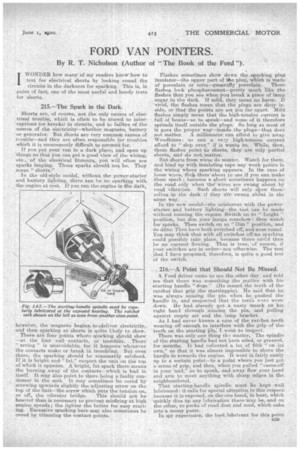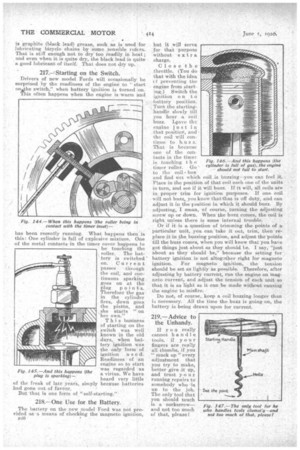FORD VAN POINTERS.
Page 25

Page 26

If you've noticed an error in this article please click here to report it so we can fix it.
By R. T. Nicholson (Author 'of "The Book of the Ford ").
IWONDER how many Of my readers know haw to
• test for electrical shorts by looking round the circuits in the darkness for sparking. This is, in point of fact, one of the most useful and handy tests for shorts.
215.--The Spark in the Dark.
Shorts are, of course, not the only canses of electrical trouble, which is often to be traced to interruptions (or breaks) in circuits, and to failtre of the source of the electricity—whether magneto, battery or generator. But Shorts are very common causes of tt ouble—and they are. often responsible for troubles which it is uncommonly difficult to account for.
If you put your van in a dark place, and open up things so that You can get a good view of the
etc., • of the electrical fitments!, yeti will ofton se sparks leaping. Tho•ss sparks ahoulal not be. They mean " shorts."
In the old-style model, without the power-starter and battery lighting, there can be no sparking with the: engine at rest. If you run the engine in the. dark, however, the magneto begins,. toadeliver electricity, and then sparking at shorts is quite likely to show:
There are four points where sparking should show —at the four coil contacts, or trembler. There " arcing " is unavoidable, for it happens whenever the contacts make or break in trembling. But even there, the sparking should be reasonably suisdued. If it is bright and "fat," suspect the unit on the top of which it appears. A bright, fat spark there means the burning away of the contacts—which is bad in itself. It may also point to there beings a faulty condenser in the unit. It may sometimes be cured by screwing upwards slightly the adjusting screw on the top of the unit—the screw which puts the tension on, or off, the vibrator bridge. This should not beheavier than. is necessary to prevent misfiring at high engine speeds; the lighter the better for easy starting. Excessive sparking here may also sometimes be aired by trimming the contact points.
Flashes sometimes show down the sparking plug insulator—the upper part of the plug, which is made of porcelain or mica—generally porcelain. These flashes look phosphoreseentaspretty much like the flashes that you see when. you break a piece of hunts
sugar in the dark. If mild, theymean no harm. If
vivid, the flashes mean that the plugs are dirty inside, or that the points are set too far apart. Mild
flashes simply mean that the high-tension current is fall of beans—so to speak—and some of it therefore spreads itself outside the plugs. SG long as most of
it goes the proper way'—inside the pluga that does not matter. A millionaire can afford to givil away Woodbines: so can a very high-tension current afford to " slop over," if it wants to. While, then, these flashes point to shorts, they are Only partial shorts, arid do not matter.
But shorts from wires do matter. Watch for them, and bind up with insulating tape any weak points in the wiring where sparking appears. In the ease of loose wires, Mel& tbenaa.bout to see if you can make them spark ; because a short sometimes happens bn the road only when the' wires are swung about by road vibration. Such shorts will only aktow them: Reaves in the dark if they aise swung about in the same way.
In the new model—the aristocrat with the powerstarter and battery lighting—the test can he Made without running the engine. Switch on to " bright" position, but dim your lamps somehow : then watch for sparks. Then switch on to "Dim" position, and do ditto. Then have both switched off,' and nose round. 'You may think that with all switches off no sparking could possibly take place, because there mold then be no' current flowing. That is _true,of course, if your switches are in order—not otherwise. The test that I have proposed, therefore, is quite a _good test of the switch.
216.—A Point that Should Not Be Missed.
A Ford -driver came to me the other day, and told me that there was something the matter with his starting handle "dogs." (He meant the teeth of the ratchet that grip the startingpin). He said that he was) always missing the pin when he pushed the handle in, and -suspected that the teeth_ were worn down. He had already got a nasty smack on his right hand through missing the pin, and pulling against empty air and the lariat) bracket..
As I had never known a case of the ratchet teeth wearing off enough to interfere with the grip of the teeth on the starting ftils; I went to inspect. '
There was only one thing the matter, The spindle of the starting handle had not been oiled, or greased, for -months. It had, collected a lot of filth "on its own," so that it was almost impossible to shove the handle in towards the engine. It went in fairly easily up to a certain point—to a point where you just got a sense of grip, and then, when you pulled " came,•off in your 'and," ao to speak, and away flew your hand and arm to meet anything with sharp edges in the neighbourhood. That starting-handle spindle must be kept) well lubricated: it calls for special attention in this respect because it is exposed, on the one hand, to heat, which quickly dies np any lubrication there may be, sand on the other, to pecks of road dust and mud, which cake into .a messy paste.
In ray eXperience; the beaf lubricant for this point 539 is graphite (black lead) grease, such as is used for lubricating bicycle chains by some sensible riders. That is stiff enough not to dry' too readily in boat; and even when it is quite dry, the black lead is quite a good lubricant of itself. That does not dry up.
217.—Starting on the Switch.
Drivers of new model Fords will occasionally be surprised by the readiness of the engine to " start on the switch,", when battery ignition is turned on. This often happens when the engine is warm and has been recently running. What happens then is this: One cylinder is full of explosive mixture. One of the metal contacts in the timer cover happens to be touching the
roller. The battery is switched on. Current
passes through the coil, and continuous sparking goes on at the plug points. Therefore the gas in the cylinder fires, down goes the pisttm, and , she starts " on 'her own."
This business of starting on the switch was well known in the old days, when battery ignition was the only form of ignition u s c d. Readiness of an engine so to start 'was regarded as a virtue. We have heard very little of the freak of late years, simply because batteries had gone out of favour.
But -that is one form of "self-starting."
Fig 145.—And this happens (the plug is sparking)—
218.—One Use for the Battery.
The battery on the new model Ford was not provided as • a means of checking the magneto ignition, al0 but it will serve for that purpose without extra charge.
Close the throttle. (You do that with the idea ef preventing the engine from starting.) Switch the ignition o n t o battery position. Turn the startinghandle slowly till you hear a coil buzz. Leave the engine just in that position, and the coil will continue to b,u z z. That is because one of the contacts in the timer
is touching t h . e
to the coil box and find out which coil is buzzing—you can feel it. Place in the position of that coil each one of the units in turn, and see if it will buzz. If it will, all coils are in proper trim for ignition purposes. If one coil will not buzz, you.know that that is oil duty, and can adjust it in the position in which it should buzz. By adjusting, I mean, of course, turning the adjusting screw up or down. When the buzz conies, the coil is right unless there is some internal trouble.
Or if it is a question of trimming the points of a particular unit, you, can take it out, trim, then replace it in the buzzing position, and adjust the points till the buzz comes, when you will know that you have got things just about as they should be. I say, "just about as they should be," because the setting for battery ignition j5i not altogether right for magneto ignition. For magneto ignition, the 'tension' should be set as lightly as possible. ;Therefore,' after adjusting by battery current, run the engine on inagneto current, and adjust the tension of each unit so that it is as light as it can be made without causing' the engine to misfire.
Do not, of course, keep a coil buzzing longer than is necessary. All the time the buzz is going on, the battery is being drawn upon for current,
2I9.—Advice to the Unhandy.
If y o u really cannot handle tools, if your fingers are really all thumbs, if you "muck up "every adjustment that you try to make, better give it up, and trust your running repairs to somebody who is up to the job. The only tool that you should touch is a corkscrew— and not too much of that, please!




























